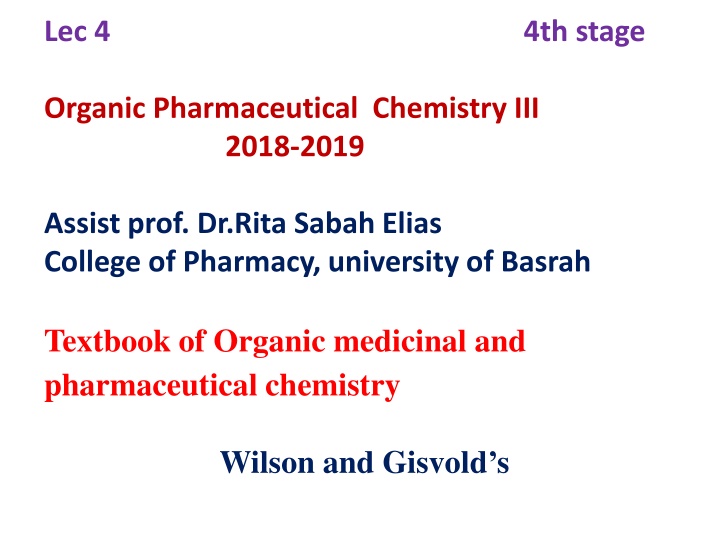
Organic Pharmaceutical Chemistry III: Penicillin and Antibiotics Overview
Learn about the properties and uses of various penicillin antibiotics, including Penicillin G, Penicillin V, Methacillin Sodium, Oxacillin Sodium, and Dicloxacillin Sodium. Understand the structural features that make these antibiotics effective against specific pathogens, their solubility, stability, and oral activity. Explore the SAR (Structure-Activity Relationship) of these antibiotics in the context of organic medicinal and pharmaceutical chemistry.
Uploaded on | 0 Views
Download Presentation

Please find below an Image/Link to download the presentation.
The content on the website is provided AS IS for your information and personal use only. It may not be sold, licensed, or shared on other websites without obtaining consent from the author. If you encounter any issues during the download, it is possible that the publisher has removed the file from their server.
You are allowed to download the files provided on this website for personal or commercial use, subject to the condition that they are used lawfully. All files are the property of their respective owners.
The content on the website is provided AS IS for your information and personal use only. It may not be sold, licensed, or shared on other websites without obtaining consent from the author.
E N D
Presentation Transcript
Lec 4 4th stage Organic Pharmaceutical Chemistry III 2018-2019 Assist prof. Dr.Rita Sabah Elias College of Pharmacy, university of Basrah Textbook of Organic medicinal and pharmaceutical chemistry Wilson and Gisvold s
Products Penicillin G (benzylpenicillin) SAR :- Unsubstituted C so the antibiotic acid liable, penicillinase sensitive, narrow spectrum. Na+ and K+ salts of penicillin G water soluble and fast acting , used orally and parenterally to achieve high plasma concentrations of penicillin G rapidly. These salts of penicillin are inactivated by the gastric juice and are not effective when administered orally unless antacids, is added. Also, because penicillin is absorbed poorly from the intestinal tract, oral doses must be very large, about five times the amount necessary with parenteral administration.
Procaine penG (Crystacillin), and Benzathine PenG( bicillin) inj. In H2O or oil, long acting
Penicillin V (Phenoxy methyl penicillin) SAR :- Electron withdrawing oxygen between C and benzene generate antibiotic with good acid stability and good oral activity. C is not substituted or remove so the antibiotic is penicillinase sensitive. narrow spectrum, lipophilic side chain, selective G+. K+ sat water soluble, fast acting, organic salt, long acting as in compocillin V
Methacillin sodium SAR:- C is removed and the carbonyl side chain is directly attach to aromatic ring so the antibiotic is penicillinase resistance. Narrow spectrum. OCH3 groups e-donors and are conjugated with acyl group so it increases - character of side chain acyl oxygen result in poor acid stability, poor oral activity.
Oxacillin Sodium SAR:- C is removed and the carbonyl side chain is directly attach 3- phenyl and 5-methyl groups of the isoxazolyl ring so the antibiotic is penicillinase resistance. It is also relatively resistant to acid hydrolysis and, therefore, may be administered orally with good effect.(e- withdrawing group isoxazole) Narrow spectrum.
Dicloxacillin sodium SAR :- C is removed and the carbonyl side chain is directly attach to arylheterocycle, so the antibiotic is penicillinase resistance. The dichloro substituent on benzene ring that is substitueted at C-3 of the isoxazole act as strong electron withdrawing groups results in decreases in the nucleophilicity of the oxygen of the acyl side chain and that lead to increase in acid stability and oral activity. Compound with only one chloro substituent on the benzene ring as in cloxacillin sodium is still with good oral activity but less than that for dicloxacillin. Compound with benzene ring only as in oxacillin this result in decrease in oral activity. However oxacillin available in oral, IM and IV dosage form. Narrow spectrum Lipophilic group.
Ampicillin SAR :- - NH2 ionizable at pH= 7.4, polar, with good inductive activity as electron withdrawing group result in good oral stability and activity and broad spectrum of activity. - Penicillinase sensitive due to the presence of hydrogen on C- . - Combination product with -lactamase inhibitor such as Sulbactam sodium= provides penicillinase resistance drug, available for IM and IV use.
Sulbactam sodium or potassium salts, selective inhibitor for -lactamase because of greater affinity to with - lactamase than penicillins. Thus protecting the antibiotics from destruction by the enzyme.
Amoxicillin SAR :- Same spectrum of activity as that for ampicillin but has increase oral availability. Spent less time in the GI tract, result in decrease in GI upset. Sensitive to -lactamase, given in combination clavulante ( Augmentin) Clavam derivative with higher affinity for -lactamase than penicillin resulted in protection from destruction as discussed with sulbactam.
Carbenicillin Disodium Adding polar functional group to C- broadens spectrum of activity ( drug is now able to penetrate through polar channels in G- cell wall),this will increase G- activity and decrease G+ activity. -COOH (most highly ionized). -COOH gives drug extended spectrum (G+, G- anaerobes) broaden than ampicillin in activity. -COOH is acid liable (COOH is electron withdrawing but undergoes acid catalyzed decarboxylation generating penicillin as shown below, for this reason cannot be given orally
to increase acid stability and retain broad spectrum, make an ester (prodrug)out of the -carboxyl group, hydrolysis then occurs by esterases in plasma to give carbenicillin as shown below. 1. penicillinase sensitive (C- - hydrogen present). 2. R- isomer = S-isomer in terms of potency.
Ticarcillin, Carbenicillin analog SAR:- Activity similar to carbenicillin but thienyl ring is more polar than benzene. Is active against more anaerobes. Available in combination with potassium Clavulanate (timentine). Available as disodium salt.
Extended spectrum of activity - Series of antibiotics structurally related to ampicillin with a very broad spectrum (G+, G- and anaerobes). - All have an amide linkage between the side chain acyl group and a N-containing heterocyclic aromatic ring. - All are penicillinase sensitive. - All are given orally, IM, IV, but their structure indicate that they should show acid stability.
